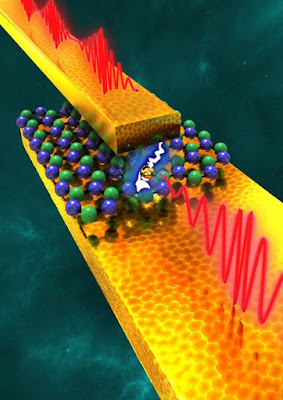 |
| A diagram of the UT Austin team's switch showing two gold electrodes with a layer of hBN in between. (Courtesy: UT Austin) |
Topics: Boron Nitride, Internet of Things, Materials Science, Nanotechnology
Two-dimensional sheets of boron nitride can be used to create an analogue switch that gives communication devices more efficient access to radio, 5G and terahertz frequencies while increasing their battery life. The switch, which was developed by a team of researchers at the University of Texas at Austin in the US and the University of Lille in France, could be employed in a host of different applications, including smartphones, mobile systems and the “Internet of things”.
Analogue switches are routinely employed in communication systems to switch from one frequency band to another, route signals between transmitting and receiving antennas, and reconfigure wireless networks. Traditionally, these switches are based on solid-state diodes or transistors, but components of this type consume energy even in standby mode, reducing the battery life of the device. With 5G networking set to drive a tenfold increase in data throughput – enabling advances in self-driving cars, delivery drones, remote surgery and fast downloads of high-definition media in the process – addressing this energy drain is more urgent than ever.
5G switching gets a 2D boost, Isabelle Dumé, Physics World
Comments